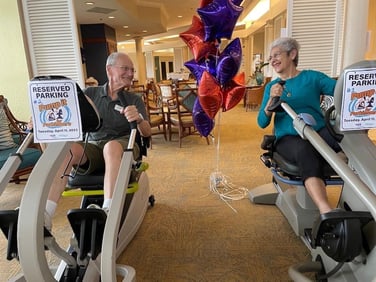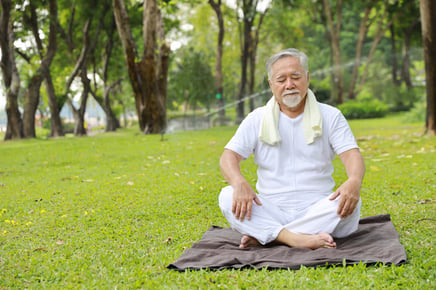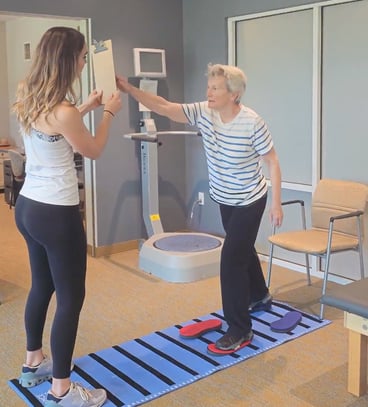 As we age, physicians and specialty doctors will talk to you about exercise and eating a well-balanced diet. We sometimes forget that brain health is just as important. Concentration on moving or getting 30 minutes of exercise per day, and strength training 2-3x a week, but is there any emphasis on brain exercises? If so, what does it look like? Are your residents participating in an craft or art? Are they doing word or cross word puzzles, easy math, or reading aloud? Are they resting their mind, or meditating?
As we age, physicians and specialty doctors will talk to you about exercise and eating a well-balanced diet. We sometimes forget that brain health is just as important. Concentration on moving or getting 30 minutes of exercise per day, and strength training 2-3x a week, but is there any emphasis on brain exercises? If so, what does it look like? Are your residents participating in an craft or art? Are they doing word or cross word puzzles, easy math, or reading aloud? Are they resting their mind, or meditating?
We all fear losing some of our memory and cognitive function. As we age, it is normal to feel a sense of insecurity when we misplace our phone or keys, or even forgetting a step in a craft that you’ve done for many years. There are a lot of brain health exercises that the residents can participate in, it is just finding the ones they love to do where it is easy, slightly complex, but enjoyable.
There are many simple activities that we can do to engage our brain. Here are a few easy ways to engage the brain, and possibly decrease risk of memory loss. An easy way to help brain health is engaging with your neighbor, a friend, or a family member and discussing current life events, attending a church service, or maybe a music/ theater event. Another simple exercise is handwriting notes or sending handwritten cards. Handwriting engages the brain more than sending a text or an emoji.
And of course, there are “brain” games that we can play on our phones or iPads. Look at your phone and check out the word games, or the simple math problems. Simple math problems can engage the prefrontal cortex of the brain. Doing simple math is an easy way to exercise your mind. Keep in mind, when it becomes too stressful, you need to decrease the complexity of math problems. Stress is not beneficial for your mind and body.
Another awesome thing you can do for your brain health is to learn a new craft or perfecting your current craft. Is there another advance step you can put into your current craft or skill to make it more challenging, such as learning a new stitch or a new painting style? These ideas can give you a sense of control and purpose. Lastly, meditate and rest your mind, if you love sleep, SLEEP, it is good for your body and mind.
So how are you engaging with the residents in brain health or brain classes? What sorts of activities or classes are you hosting to entice the residents?


 Regular exercise is incredibly beneficial for people with Parkinson’s disease (PD). It helps manage symptoms like stiffness, gait issues, posture, and balance deficiencies. Individual exercises can build into complex movement patterns, eventually evolving into activities such as dancing, yoga, and boxing. Since PD presents itself uniquely in each person, no two exercise programs will look the same. A personalized plan that takes into account both the individual’s daily needs and the activities they enjoy most will have the greatest impact on improving their quality of life.
Regular exercise is incredibly beneficial for people with Parkinson’s disease (PD). It helps manage symptoms like stiffness, gait issues, posture, and balance deficiencies. Individual exercises can build into complex movement patterns, eventually evolving into activities such as dancing, yoga, and boxing. Since PD presents itself uniquely in each person, no two exercise programs will look the same. A personalized plan that takes into account both the individual’s daily needs and the activities they enjoy most will have the greatest impact on improving their quality of life.
 At NIFS, we believe in the power of movement. That’s why our partnership with
At NIFS, we believe in the power of movement. That’s why our partnership with 
 Aging gracefully starts with the right nutrients! Good health doesn’t happen by chance—it requires proactive choices. Nutrition is important for every generation, but it becomes even more critical as we age. As we grow older, our nutritional needs change, and understanding what’s essential can make all the difference in staying active, healthy, and full of energy. In this blog, we will discuss why your nutritional needs change with age, key nutrients to focus on, and easy ways to incorporate them into your life.
Aging gracefully starts with the right nutrients! Good health doesn’t happen by chance—it requires proactive choices. Nutrition is important for every generation, but it becomes even more critical as we age. As we grow older, our nutritional needs change, and understanding what’s essential can make all the difference in staying active, healthy, and full of energy. In this blog, we will discuss why your nutritional needs change with age, key nutrients to focus on, and easy ways to incorporate them into your life. You are scrolling through social media for entertainment and inspiration, and you see the person you want to be like. They are fit, energetic, happy, and have been consistent with their workouts for years now. Maybe you’ve been exercising on and off for a while but can’t find the routine that you can stick to. Well, it’s a new year, so… “New year, new plan!”
You are scrolling through social media for entertainment and inspiration, and you see the person you want to be like. They are fit, energetic, happy, and have been consistent with their workouts for years now. Maybe you’ve been exercising on and off for a while but can’t find the routine that you can stick to. Well, it’s a new year, so… “New year, new plan!”
 Staying active and making healthy choices is important, especially as we get older. Strength training and maintaining a healthy body composition can make a big difference in how we move, look, and feel as we age.
Staying active and making healthy choices is important, especially as we get older. Strength training and maintaining a healthy body composition can make a big difference in how we move, look, and feel as we age. Picture this: You're gliding effortlessly across a small trampoline, the rhythmic bouncing sending a gentle wave of energy through your body. This isn't just some childhood fantasy; it's rebounding, a low-impact exercise gaining popularity among senior citizens for its myriad health benefits.
Picture this: You're gliding effortlessly across a small trampoline, the rhythmic bouncing sending a gentle wave of energy through your body. This isn't just some childhood fantasy; it's rebounding, a low-impact exercise gaining popularity among senior citizens for its myriad health benefits. Last year, the only complaint we heard about Pump it for Parkinson’s was several communities heard about it too late and missed out on the fun!
Last year, the only complaint we heard about Pump it for Parkinson’s was several communities heard about it too late and missed out on the fun!  It has often been thought that core strength can only to be achieved through sit ups, crunches, and planks but in recent years there has been a lot more discussion about the way we breathe and how it effects our core. If you participate in 1-1 training or group fitness, you have probably heard your trainer tell you to breathe and brace your core through a particular exercise. What does it mean to effectively brace your core and why is it important? Is it to see your abdominals, provide you strength or to help with your posture? In all reality, we use our core for many daily tasks such as standing tall, getting up off a chair, or even walking. Learning how to brace your core is fundamental in creating a strong foundation for all movements and can also help to aide in injury prevention.
It has often been thought that core strength can only to be achieved through sit ups, crunches, and planks but in recent years there has been a lot more discussion about the way we breathe and how it effects our core. If you participate in 1-1 training or group fitness, you have probably heard your trainer tell you to breathe and brace your core through a particular exercise. What does it mean to effectively brace your core and why is it important? Is it to see your abdominals, provide you strength or to help with your posture? In all reality, we use our core for many daily tasks such as standing tall, getting up off a chair, or even walking. Learning how to brace your core is fundamental in creating a strong foundation for all movements and can also help to aide in injury prevention. Every senior living community offers group fitness classes. If you want to stand out from the competition, you have to offer more.
Every senior living community offers group fitness classes. If you want to stand out from the competition, you have to offer more.